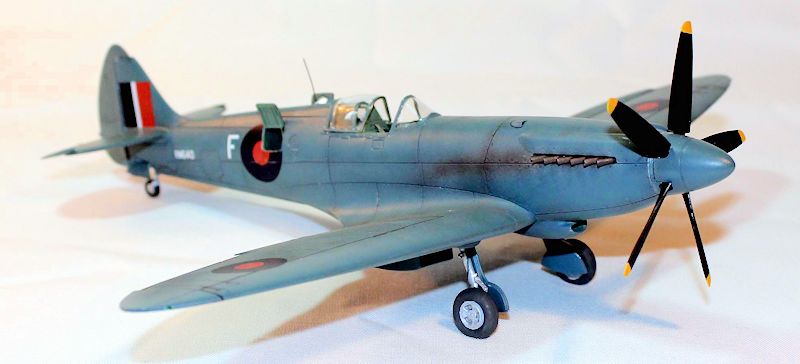
Airfix 1/48 Spitfire PR.XIX
| KIT #: | A05119 |
| PRICE: | $21.00 |
| DECALS: | Two options |
| REVIEWER: | Fernando Rolandelli |
| NOTES: |

| HISTORY |
If the status of the Spitfire as “the best fighter
aircraft of WW2” can be doubted, its condition as “the best medium range
reconnaissance aircraft” probably cannot. Without in any way having been
designed for the role, Spitfires were modified for the reconnaissance role from
the very beginning, at first in an almost artisan scale, and it were PR
Spitfires the first to be deployed overseas and make contact with the enemy.
Later, beginning with the PR.IV, production was standardized, as was the scheme
“fuel in wings, cameras in fuselage”, with the introduction of the so-called
“Bowser” wing, an early attempt at a “wet” wing. The last of these recce
versions, and the only one fitted with a Griffon engine, was the PR.XIX,
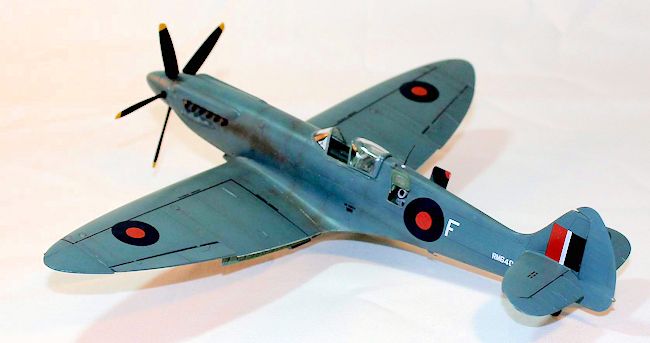 which, as
most Spitfire versions were, was a kind of an hybrid aircraft mating the general
Mk.XIV fuselage to a PR.XI wings (with extra fuel in the seldom used
wing camera bays, to a total of 256 gallons) and (type
390) PR.X pressurized system (itself an adaptation from the HF.VII), modified
with a “PR windscreen”, without armor. It was a remarkable aircraft, with a top
speed of 717 km/h at 26,000 ft, and a maximun ceiling of 42,600, a figure
reached almost unofficially. Entering service in May, 1944, 225 were built, seen
widespread service in Europe and Italy before the end of the war.
which, as
most Spitfire versions were, was a kind of an hybrid aircraft mating the general
Mk.XIV fuselage to a PR.XI wings (with extra fuel in the seldom used
wing camera bays, to a total of 256 gallons) and (type
390) PR.X pressurized system (itself an adaptation from the HF.VII), modified
with a “PR windscreen”, without armor. It was a remarkable aircraft, with a top
speed of 717 km/h at 26,000 ft, and a maximun ceiling of 42,600, a figure
reached almost unofficially. Entering service in May, 1944, 225 were built, seen
widespread service in Europe and Italy before the end of the war.
No.682 Squadron was formed from No.4 Photographic Reconnaissance Unit at Maison Blanche on 1 February 1943, for photographic reconnaissance duties in the Western and Central Mediterranean. After flying missions over Tunisia and Italy from Algeria, it moved to Italy in December 1943, mounted on Spitfire PR Mk XIs, and for the rest of the war based detachments at many airfields in Italy. In September 1944 it began being reequipped with PR.XIX; about that same time, a detachment was sent to southern France which moved forward behind the Allied armies until it reached Nancy in November, where it stayed until the end of March 1945. On 14 September 1945 the squadron was disbanded.
| THE KIT |
This most eagerly awaited kit is one of those embodying the virtual resurrection of Airfix to the “kits for serious modellers” market. You can read a more detailed preview here.
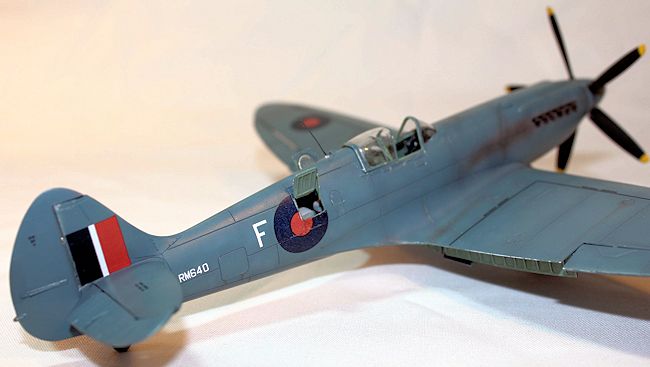 The first
impressions are good. Plastic is a bit soft, but some people like it best. Panel
lines are still a bit oversized but well defined. Small parts are rather poor,
specially the undercarriage. Cockpit detail is barely adequate; but the seat
looks very good. Armour is molded into the headrest bulkhead, which surprised
me; though in wartime it looks to have been fitted (against PR practice), the
post-war machines depicted in the decal sheet had it most probably removed.
The first
impressions are good. Plastic is a bit soft, but some people like it best. Panel
lines are still a bit oversized but well defined. Small parts are rather poor,
specially the undercarriage. Cockpit detail is barely adequate; but the seat
looks very good. Armour is molded into the headrest bulkhead, which surprised
me; though in wartime it looks to have been fitted (against PR practice), the
post-war machines depicted in the decal sheet had it most probably removed.
The moulds are “PR.XIX specific”, it doesn't look as
if they were planned as a multiversion mould. Every one of the three plus
transparent sprues have “XIX specific” parts. Airfix will be able to profit of
the research only if releasing a XIV or XVIII model.
| CONSTRUCTION |
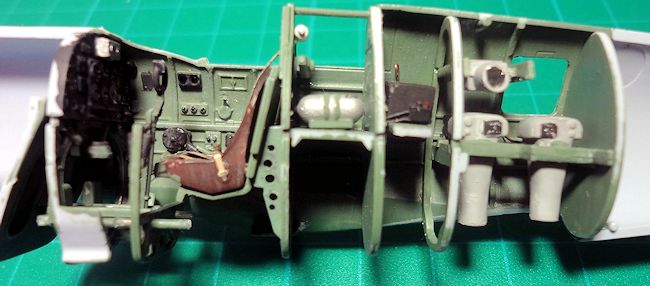 had
problems in identifying the throttle lever, there is a similar lever in the
forward bulkhead which is an oversized pump lever. The thing I most regretted
not being able to replace were the rudder pedals, a bare slab of plastic. Had I
had my spare parts box with me, I would have used even the discarded plastic
ones from any kit. Luckily, they are not that visible. I bored the holes around
the seat mounting and bulkhead.
had
problems in identifying the throttle lever, there is a similar lever in the
forward bulkhead which is an oversized pump lever. The thing I most regretted
not being able to replace were the rudder pedals, a bare slab of plastic. Had I
had my spare parts box with me, I would have used even the discarded plastic
ones from any kit. Luckily, they are not that visible. I bored the holes around
the seat mounting and bulkhead.
The camera compartment is a very good addition to the
kit; having been in the “PR Spits” business for some time, I have long prayed
for some aftermarket company releasing something like that. I decided to open
the hatches on both sides, but it would be probably a better idea to open only
the one with the camera port.
Everything was painted in Aircraft Grey Green, as I
intended to model a wartime machine. The cameras were painted a light grey.
Exterior

The canopy/rear window combo, another usual Airfix's
Spits trait, is ridiculous, and I honestly think there is no way it may look
anywhere near realistic. I therefore chose to simply put the hood opened on its
rails. The quarterdeck window is a bit small in width compared to its sills; I
worked a bit to get a better fit, but, in the end, it backfired, for the hood
would have sat easier on it. I had to force it a bit to avoid it riding high.
| COLORS & MARKINGS |
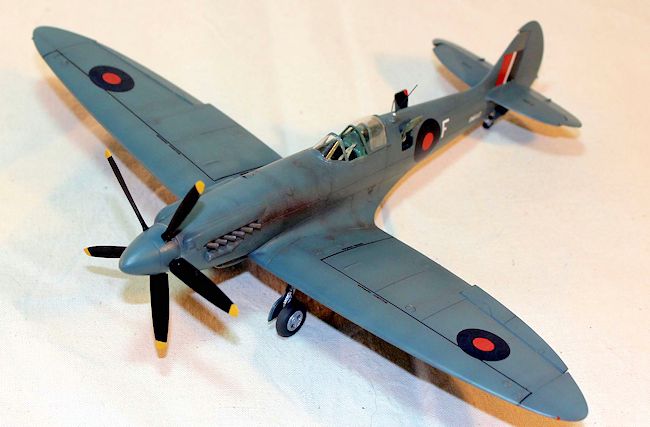 it
“mottle-fashion” in several shades of the base colour on a dark preshade, to
achieve an uneven look. While the interior and details were brush painted with
Humbrol paints (the ones available at Nairobi), the exterior was painted with
Xtracolor and a Paasche VL.
it
“mottle-fashion” in several shades of the base colour on a dark preshade, to
achieve an uneven look. While the interior and details were brush painted with
Humbrol paints (the ones available at Nairobi), the exterior was painted with
Xtracolor and a Paasche VL.
| CONCLUSIONS |
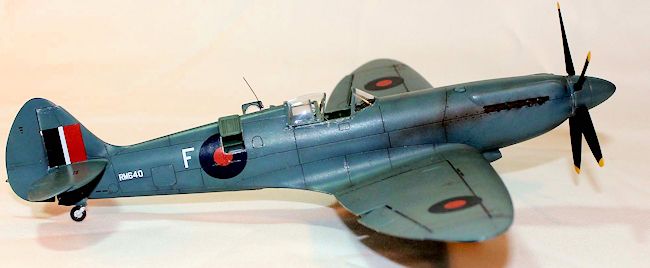
| REFERENCES |
- “Spitfire at War”, Alfred Price, Ian Allan
Publications
- RAF website
September 2013 If you would like your product reviewed fairly and
fairly quickly, please
contact
the editor
or see other details in the
Note to
Contributors.